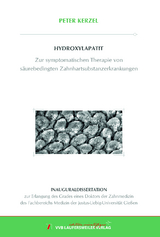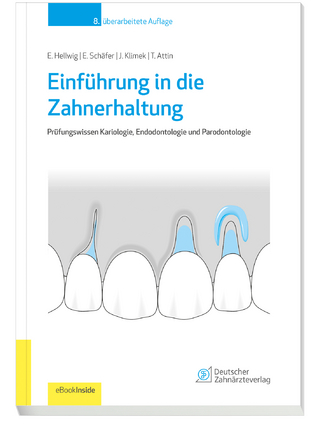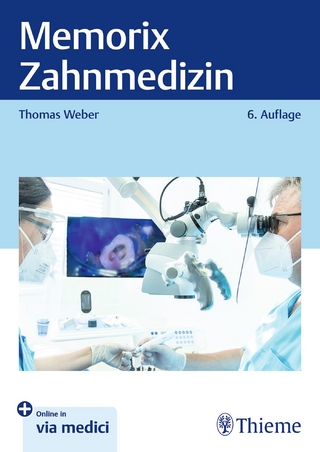HYDROXYLAPATIT - Zur symptomatischen Therapie von säurebedingten Zahnhartsubstanzerkrankungen
Seiten
2023
VVB Laufersweiler Verlag
978-3-8359-7106-6 (ISBN)
VVB Laufersweiler Verlag
978-3-8359-7106-6 (ISBN)
- Keine Verlagsinformationen verfügbar
- Artikel merken
Säurebedingte Zahnhartsubstanzverluste (Erosionen) rücken, wie die Deutschen Mundgesundheitsstudien (DMS) zeigen, verstärkt in den Fokus der Zahnmedizin. Auch Hersteller von Zahnpflegeprodukten bringen immer mehr Produkte auf den Markt, die mit speziellen Wirkstoffen gegen diese Zahnhartsubstanzverluste schützen sollen. So sind seit einiger Zeit auch Zahnpflegeprodukte mit Hydroxylapatit als Wirkstoff gegen Erosionen erhältlich. Bislang ist allerdings wenig über die Effekte, die Wirkungsweise und den Wirkmechanismus des neuen Wirkstoffes, insbesondere in Zahnpflegeprodukten, bekannt.
Das Ziel dieser Dissertation war es deshalb zu zeigen, ob der neue Wirkstoff Hydroxylapatit in der symptomatischen Therapie von säurebedingten Zahnhartsubstanzverlusten eingesetzt werden kann. Außerdem sollte die Wirkungsweise und der Wirkmechanismus analysiert werden. Hierzu sollten die folgenden Fragen beantwortet werden:
•Kann Hydroxylapatit den erosiv bedingten Zahnhartsubstanzverlust gegenüber der Negativkontrolle effektiv verringern?
•Kann Hydroxylapatit den erosiv bedingten Zahnhartsubstanzverlust gegenüber etablierten Wirkstoffen effektiv verringern?
•Sind Präzipitate nach der Anwendung von Hydroxylapatit auf erodierten Schmelzoberflächen nachweisbar?
•In welcher Form liegt Hydroxylapatit in den Zahnpasten und Mundspüllösungen vor?
Um diese Fragen zu beantworten, wurden drei Hydroxylapatitformulierungen (zwei Zahnpasten, eine Mundspüllösung), zwei Kombinationszahnpasten (hydroxylapatit- und fluoridhaltig), zwei zinn- und fluoridhaltige Produkte (Positivkontrolle; eine Zahnpaste, eine Mundspüllösung) und eine wirkstofffreie Zahnpaste (Negativkontrolle) untersucht. Es wurde der Substanzverlust von humanen Schmelzproben in einem Erosions-/Abrasionsmodell nach Behandlung mit den Versuchsprodukten gemessen. Außerdem wurden erodierte Schmelzoberflächen nach einerseits In-vitro- und andererseits In-situ-Anwendung der Zahnpflegeprodukte auf morphologische Veränderungen rasterelektronenmikroskopisch untersucht. Zusätzlich wurden die relevanten Parameter der Zahnpflegeprodukte wie die pH-Werte und die Fluorid- und Kalziumkonzentration analysiert. Es wurde der Partikelgehalt der Zahnpasten ermittelt, die Partikel der Zahnpasten auf ihre Form, Größe und Oberflächenbeschaffenheit hin analysiert und die RDA /REA-Werte der Zahnpasten bestimmt.
Bei der Substanzverlustmessung konnte weder unter alleiniger Erosion noch unter zusätzlicher Abrasion eine signifikante Reduktion durch hydroxylapatithaltige Produkte (Hydroxylapatitformulierungen und Kombinationszahnpasten) gegenüber der Negativkontrolle festgestellt werden. Bei einigen Anwendungen erhöhte sich sogar der Substanzverlust. Auch gegenüber den Positivkontrollen zeigen fast alle hydroxylapatithaltigen Produkte signifikant schlechtere Ergebnisse. Lediglich bei der Anwendung einer der Kombinationszahnpasten und der hydroxylapatithaltigen Mundspüllösung unter zusätzlicher Abrasion konnten keine signifikanten Unterschiede zur Anwendung der Positivkontrollzahnpaste festgestellt werden. Die Positivkontrollmundspüllösung war allen anderen Produkten signifikant überlegen. Eine Korrelation zum Partikelgehalt, den pH- sowie den RDA- und REA-Werten war nicht erkennbar. Zum Fluoridgehalt und der Konzentration an Kalziumionen scheint zumindest teilweise ein Zusammenhang zu bestehen.
Die morphologische Strukturanalyse der erodierten Schmelzoberflächen in vitro zeigte keine Präzipitation durch die Produkte. Die teilweise erkennbaren Veränderungen scheinen eher durch die verwendete Remineralisationslösung hervorgerufen zu werden und nicht durch die verwendeten Produkte. Auch in situ konnte keine Präzipitation nachgewiesen werden. Hier scheinen die teilweise erkennbaren Veränderungen durch eine Pellikelakkumulation hervorgerufen zu werden und probanden- und nicht produktabhängig zu sein.
Die Analyse der partikulären Phase und die Bestimmung der Konzentration an Kalziumionen lässt darauf schließen, dass sich das Hydroxylapatit nicht in hochkristalliner Form, sondern entweder an den Partikeln gebunden oder aber in Lösung in den hydroxylapatithaltigen Zahnpflegeprodukten befindet.
Die Ergebnisse der Dissertation zeigen, dass Hydroxylapatit als Wirkstoff keinen positiven Wirkeffekt gegenüber der Negativkontrolle und den etablierten Wirkstoffen bezogen auf den säurebedingten Zahnhartsubstanzverlust aufweist. Eine Präzipitation auf erodierten Zahnoberflächen konnte nicht gezeigt werden. Die Ergebnisse lassen außerdem vermuten, dass Hydroxylapatit nicht hochkristallin, sondern auf Partikeln gebunden oder in Lösung vorliegt. Hydroxylapatithaltige Mundpflegeprodukte sollten folglich nicht in der symptomatischen Erosionstherapie verwendet werden. Ein Abweichen von der bisherigen Empfehlung, zinn- und fluoridhaltige Produkte zu verwenden, erscheint als nicht sinnvoll. Acid-related tooth structure loss (erosion) is increasingly becoming the focus of dental medicine, as shown by the German Oral Health Studies (DMS). Manufacturers of dental care products are also launching more and more products on the market that are intended to protect against this loss of tooth structure with special active ingredients. Dental care products containing hydroxyapatite as an active ingredient to combat erosion have been available for some time. So far, however, little is known about the effects, mode of action and mechanism of action of the new active ingredient, particularly in dental care products.
The aim of this dissertation was therefore to show whether the new active ingredient hydroxyapatite can be used for the symptomatic therapy of acid-induced tooth structure loss. In addition, the mode of action and the mechanism of action were to be analyzed. For this purpose, the following questions should be answered:
•Can hydroxyapatite effectively reduce erosively induced tooth structure loss compared to negative control?
•Can hydroxyapatite effectively reduce erosively induced tooth structure loss compared to established active ingredients?
•Are precipitates detectable on eroded enamel after hydroxyapatite application?
•In what form is hydroxyapatite present in toothpastes and mouth rinses?
To answer these questions, the loss of substance of human enamel samples was measured in an erosion/abrasion model after treatment with the test products. Furthermore, eroded enamel surfaces were examined for morphological changes by scanning electron microscopy after in vitro or in situ application of the dental care products. In addition, further analyses of the relevant parameters of the dental care products, such as pH determination and determination of fluoride concentration and calcium concentration, were carried out. The particle content of the toothpastes was determined, the particles of the toothpastes were analyzed for their shape, size and surface texture, and the RDA /REA values were determined. Three hydroxyapatite formulations (two toothpastes, one mouth rinse), two combination toothpastes (containing hydroxyapatite and fluoride), two products containing tin and fluoride (positive control; one toothpaste, one mouth rinse) and one toothpaste containing no active ingredients (negative control) were investigated.
In the substance loss measurement, no significant reduction by hydroxyapatite-containing products (hydroxyapatite formulations and combination toothpastes) could be detected compared to the negative control, both under erosion alone and under additional abrasion. In some applications, the loss of substance even increased. Also compared to the positive controls, almost all hydroxyapatite-containing products showed significantly worse results. Only when one of the combination toothpastes and the hydroxyapatite-containing mouth rinse was applied with additional abrasion, no significant differences could be found compared to the application of the positive control toothpaste. The positive control mouth rinse was significantly superior to all other products. No correlation to particle content, pH and RDA and REA values was evident. There seems to be at least a partial correlation to the fluoride content and the concentration of calcium ions values.
Morphological structural analysis of the eroded enamel surfaces in vitro showed no precipitation by the products. The partially discernible changes seem to be caused by the remineralization solution used rather than by the products itself. No precipitation could be detected in situ either. Here, the partially detectable changes appear to be caused by pellicle coverage and to be subject-dependent rather than product-dependent.
Analysis of the particulate phase and determination of the concentration of calcium ions suggests that the hydroxyapatite is not in a highly crystalline form, but either bound to the particles or in solution in the dental care products containing hydroxyapatite.
The results of the dissertation show that hydroxyapatite as an active ingredient has no positive effect compared to the negative control as well as the established active ingredients regarding acid-induced tooth structure loss. Precipitation on eroded tooth surfaces could not be demonstrated. The results also suggest that hydroxyapatite is not highly crystalline but bound on particles or in solution. Consequently, oral care products containing hydroxyapatite should not be used in symptomatic erosion therapy. A deviation from the previous recommendation to use products containing stannous and fluoride does not appear to be reasonable.
Das Ziel dieser Dissertation war es deshalb zu zeigen, ob der neue Wirkstoff Hydroxylapatit in der symptomatischen Therapie von säurebedingten Zahnhartsubstanzverlusten eingesetzt werden kann. Außerdem sollte die Wirkungsweise und der Wirkmechanismus analysiert werden. Hierzu sollten die folgenden Fragen beantwortet werden:
•Kann Hydroxylapatit den erosiv bedingten Zahnhartsubstanzverlust gegenüber der Negativkontrolle effektiv verringern?
•Kann Hydroxylapatit den erosiv bedingten Zahnhartsubstanzverlust gegenüber etablierten Wirkstoffen effektiv verringern?
•Sind Präzipitate nach der Anwendung von Hydroxylapatit auf erodierten Schmelzoberflächen nachweisbar?
•In welcher Form liegt Hydroxylapatit in den Zahnpasten und Mundspüllösungen vor?
Um diese Fragen zu beantworten, wurden drei Hydroxylapatitformulierungen (zwei Zahnpasten, eine Mundspüllösung), zwei Kombinationszahnpasten (hydroxylapatit- und fluoridhaltig), zwei zinn- und fluoridhaltige Produkte (Positivkontrolle; eine Zahnpaste, eine Mundspüllösung) und eine wirkstofffreie Zahnpaste (Negativkontrolle) untersucht. Es wurde der Substanzverlust von humanen Schmelzproben in einem Erosions-/Abrasionsmodell nach Behandlung mit den Versuchsprodukten gemessen. Außerdem wurden erodierte Schmelzoberflächen nach einerseits In-vitro- und andererseits In-situ-Anwendung der Zahnpflegeprodukte auf morphologische Veränderungen rasterelektronenmikroskopisch untersucht. Zusätzlich wurden die relevanten Parameter der Zahnpflegeprodukte wie die pH-Werte und die Fluorid- und Kalziumkonzentration analysiert. Es wurde der Partikelgehalt der Zahnpasten ermittelt, die Partikel der Zahnpasten auf ihre Form, Größe und Oberflächenbeschaffenheit hin analysiert und die RDA /REA-Werte der Zahnpasten bestimmt.
Bei der Substanzverlustmessung konnte weder unter alleiniger Erosion noch unter zusätzlicher Abrasion eine signifikante Reduktion durch hydroxylapatithaltige Produkte (Hydroxylapatitformulierungen und Kombinationszahnpasten) gegenüber der Negativkontrolle festgestellt werden. Bei einigen Anwendungen erhöhte sich sogar der Substanzverlust. Auch gegenüber den Positivkontrollen zeigen fast alle hydroxylapatithaltigen Produkte signifikant schlechtere Ergebnisse. Lediglich bei der Anwendung einer der Kombinationszahnpasten und der hydroxylapatithaltigen Mundspüllösung unter zusätzlicher Abrasion konnten keine signifikanten Unterschiede zur Anwendung der Positivkontrollzahnpaste festgestellt werden. Die Positivkontrollmundspüllösung war allen anderen Produkten signifikant überlegen. Eine Korrelation zum Partikelgehalt, den pH- sowie den RDA- und REA-Werten war nicht erkennbar. Zum Fluoridgehalt und der Konzentration an Kalziumionen scheint zumindest teilweise ein Zusammenhang zu bestehen.
Die morphologische Strukturanalyse der erodierten Schmelzoberflächen in vitro zeigte keine Präzipitation durch die Produkte. Die teilweise erkennbaren Veränderungen scheinen eher durch die verwendete Remineralisationslösung hervorgerufen zu werden und nicht durch die verwendeten Produkte. Auch in situ konnte keine Präzipitation nachgewiesen werden. Hier scheinen die teilweise erkennbaren Veränderungen durch eine Pellikelakkumulation hervorgerufen zu werden und probanden- und nicht produktabhängig zu sein.
Die Analyse der partikulären Phase und die Bestimmung der Konzentration an Kalziumionen lässt darauf schließen, dass sich das Hydroxylapatit nicht in hochkristalliner Form, sondern entweder an den Partikeln gebunden oder aber in Lösung in den hydroxylapatithaltigen Zahnpflegeprodukten befindet.
Die Ergebnisse der Dissertation zeigen, dass Hydroxylapatit als Wirkstoff keinen positiven Wirkeffekt gegenüber der Negativkontrolle und den etablierten Wirkstoffen bezogen auf den säurebedingten Zahnhartsubstanzverlust aufweist. Eine Präzipitation auf erodierten Zahnoberflächen konnte nicht gezeigt werden. Die Ergebnisse lassen außerdem vermuten, dass Hydroxylapatit nicht hochkristallin, sondern auf Partikeln gebunden oder in Lösung vorliegt. Hydroxylapatithaltige Mundpflegeprodukte sollten folglich nicht in der symptomatischen Erosionstherapie verwendet werden. Ein Abweichen von der bisherigen Empfehlung, zinn- und fluoridhaltige Produkte zu verwenden, erscheint als nicht sinnvoll. Acid-related tooth structure loss (erosion) is increasingly becoming the focus of dental medicine, as shown by the German Oral Health Studies (DMS). Manufacturers of dental care products are also launching more and more products on the market that are intended to protect against this loss of tooth structure with special active ingredients. Dental care products containing hydroxyapatite as an active ingredient to combat erosion have been available for some time. So far, however, little is known about the effects, mode of action and mechanism of action of the new active ingredient, particularly in dental care products.
The aim of this dissertation was therefore to show whether the new active ingredient hydroxyapatite can be used for the symptomatic therapy of acid-induced tooth structure loss. In addition, the mode of action and the mechanism of action were to be analyzed. For this purpose, the following questions should be answered:
•Can hydroxyapatite effectively reduce erosively induced tooth structure loss compared to negative control?
•Can hydroxyapatite effectively reduce erosively induced tooth structure loss compared to established active ingredients?
•Are precipitates detectable on eroded enamel after hydroxyapatite application?
•In what form is hydroxyapatite present in toothpastes and mouth rinses?
To answer these questions, the loss of substance of human enamel samples was measured in an erosion/abrasion model after treatment with the test products. Furthermore, eroded enamel surfaces were examined for morphological changes by scanning electron microscopy after in vitro or in situ application of the dental care products. In addition, further analyses of the relevant parameters of the dental care products, such as pH determination and determination of fluoride concentration and calcium concentration, were carried out. The particle content of the toothpastes was determined, the particles of the toothpastes were analyzed for their shape, size and surface texture, and the RDA /REA values were determined. Three hydroxyapatite formulations (two toothpastes, one mouth rinse), two combination toothpastes (containing hydroxyapatite and fluoride), two products containing tin and fluoride (positive control; one toothpaste, one mouth rinse) and one toothpaste containing no active ingredients (negative control) were investigated.
In the substance loss measurement, no significant reduction by hydroxyapatite-containing products (hydroxyapatite formulations and combination toothpastes) could be detected compared to the negative control, both under erosion alone and under additional abrasion. In some applications, the loss of substance even increased. Also compared to the positive controls, almost all hydroxyapatite-containing products showed significantly worse results. Only when one of the combination toothpastes and the hydroxyapatite-containing mouth rinse was applied with additional abrasion, no significant differences could be found compared to the application of the positive control toothpaste. The positive control mouth rinse was significantly superior to all other products. No correlation to particle content, pH and RDA and REA values was evident. There seems to be at least a partial correlation to the fluoride content and the concentration of calcium ions values.
Morphological structural analysis of the eroded enamel surfaces in vitro showed no precipitation by the products. The partially discernible changes seem to be caused by the remineralization solution used rather than by the products itself. No precipitation could be detected in situ either. Here, the partially detectable changes appear to be caused by pellicle coverage and to be subject-dependent rather than product-dependent.
Analysis of the particulate phase and determination of the concentration of calcium ions suggests that the hydroxyapatite is not in a highly crystalline form, but either bound to the particles or in solution in the dental care products containing hydroxyapatite.
The results of the dissertation show that hydroxyapatite as an active ingredient has no positive effect compared to the negative control as well as the established active ingredients regarding acid-induced tooth structure loss. Precipitation on eroded tooth surfaces could not be demonstrated. The results also suggest that hydroxyapatite is not highly crystalline but bound on particles or in solution. Consequently, oral care products containing hydroxyapatite should not be used in symptomatic erosion therapy. A deviation from the previous recommendation to use products containing stannous and fluoride does not appear to be reasonable.
| Erscheinungsdatum | 23.03.2023 |
|---|---|
| Reihe/Serie | Edition Scientifique |
| Verlagsort | Gießen |
| Sprache | deutsch |
| Maße | 148 x 210 mm |
| Gewicht | 250 g |
| Themenwelt | Medizin / Pharmazie ► Zahnmedizin ► Klinik und Praxis |
| Schlagworte | Acid-related tooth structure loss (erosion) • Behandlung • Oberfläche • Säure • Zahnhartsubstanz • Zahnsubstanz |
| ISBN-10 | 3-8359-7106-9 / 3835971069 |
| ISBN-13 | 978-3-8359-7106-6 / 9783835971066 |
| Zustand | Neuware |
| Haben Sie eine Frage zum Produkt? |
Mehr entdecken
aus dem Bereich
aus dem Bereich
Prüfungswissen Kariologie, Endodontologie und Parodontologie
Buch (2023)
Deutscher Ärzteverlag
69,99 €




